
A wargame is a strategy game that realistically simulates warfare. Wargames were invented for the purpose of training military officers, but they eventually caught on in civilian circles, played recreationally.

A wargame is a strategy game that realistically simulates warfare. Wargames were invented for the purpose of training military officers, but they eventually caught on in civilian circles, played recreationally.
The first wargame was invented in Prussia in 1780 by Johann Christian Ludwig Hellwig, who was a college professor in Brunswick. Hellwing wanted to design a game by which he could teach some principles of warfare to his students, many of whom were noblemen destined for military service, but he also wanted his game to be fun and accessible to the general public so that he could sell it as a leisure game. Hellwig chose to base his game on chess, believing that this would attract chess players and make it easier for them to learn the rules. [1] Hellwig published a second edition of his rulebook in 1803.
As in chess, Hellwig's game was played on a grid of squares, but it was a much larger grid, and the squares were color-coded to represent different types of terrain: mountains, swamp, water, trenches, etc. The layout of the terrain was not fixed, which allowed players to create their own custom battlefields. The pieces in the game represented real military units: cavalry, infantry, artillery, and various support units. As in chess, only a single piece could occupy a square, and the pieces moved square by square, either laterally or diagonally. Over normal terrain, infantry could move a maximum distance of eight squares, dragoons could move twelve squares, and light cavalry could move sixteen squares — intuitively mirroring the speed at which these units move in the real world. But terrain could impede movement: mountains were impassable, swamps slowed units down, rivers could only be crossed with the help of a special pontoon unit, etc. A player could only move one piece per turn, or one group of pieces if they were arranged in a rectangle. A piece could capture an enemy piece by moving into its square, just like in chess, but infantry and artillery pieces could also shoot enemy pieces, at a maximum ranges of two to three squares. Unlike chess, the pieces had orientation: for instance, an infantry piece could only shoot an enemy piece if they were facing it and flanking it. [2] [3] Hellwig's wargame could also simulate the fog of war to a limited degree: while the players were arranging their pieces in their starting positions, they had the option of placing a screen across the board so that they could not observe their opponent's arrangement until the game started. Once the game was in progress, however, there was no hiding anything.
Hellwig's wargame was a great success, and inspired other inventors to develop their own chess-like wargames. [4]
In 1796, another Prussian named Johann Georg Julius Venturini invented his own wargame, inspired by Hellwig's game. Venturini's game was played on an even larger grid. [5] Venturini's game also added rules governing logistics, such as supply convoys and mobile bakeries, and the effects of weather and seasons, making it perhaps the first operational-level wargame. [6] [7]
In 1806, an Austrian named Johann Ferdinand Opiz developed a wargame aimed at both civilian and military markets. Like Hellwig's game, it used a modular grid-based board. But unlike Hellwig's game, Opiz's game used dice rolls to simulate the unpredictability of real warfare. This innovation was controversial at the time. [8] Hellwig, who designed his wargame for both leisure as well as instruction, felt that introducing chance would spoil the fun. [9]
These games were popular among recreational gamers, but were not taken seriously by an army because they were too unrealistic. The chess-like grid forced the terrain into unnatural forms, such as rivers that flowed in straight lines and turned at right angles. A unit could only move from one square to the next, not within the square, and only a single unit could occupy a square at a time, even if that square represented a square mile. [10] [11]
In 1824, a Prussian army officer named Georg Heinrich Rudolf Johann von Reisswitz developed a more realistic wargame specifically for the Prussian army. Instead of a chess-like grid, the game was played on accurate topographical maps of the kind the Prussian army used in the field. This allowed the game to model terrain naturally and simulate battles in real locations. The scale of the map was 1:8000; smaller than any wargame before it. Troop formations were represented by little rectangular pieces made of lead, which were painted either blue or red to represent the side they belonged to. Reisswitz used data collected during the Napoleonic Wars to accurately model how the units performed in battle. For instance, his manual provided tables which listed how far each unit type could move in a round over various types of terrain. The game used dice to model variable weapon damage, and firearm damage generally decreased the farther away the target was. Unlike chess pieces, the units could suffer partial losses before being defeated, which were tracked on a separate sheet of paper; Reisswitz's wargame was the first to use unit hitpoints. The most important innovation was perhaps the introduction of an umpire. The players did not move the pieces across the map themselves. Instead, they wrote orders for their troops on scraps of paper which they discretely submitted to the umpire, and the umpire would move the pieces according to how he judged the virtual troops would carry out their orders. The umpire also managed secret information such as the locations of hidden units. The umpire only placed a piece on the map when he judged that the unit in question had entered the enemy's line of sight; this was the first wargame to properly simulate the fog of war.
A number of privately-funded kriegsspiel clubs were formed in Prussia. They were mainly frequented by army officers, but some had civilian members as well, so kriegsspiel was certainly being played recreationally during this time.
In 1870, Prussia defeated France in the Franco-Prussian War. The Prussian army did not have any significant advantage in weaponry, numbers, or troop training, but it was the only army in the world that practiced wargaming, so naturally many people credited Prussia's victory to its wargaming tradition. [12] [13] Armies around the world now took an interest in German wargames, which they referred to as kriegsspiel (the German word for "wargame"). Kriegsspiel also gained a substantial following among civilian gamers. The world's first recreational wargaming club was the University Kriegspiel [sic] Club, founded in 1873 at Oxford University in England.
In 1881, the Scottish writer Robert Louis Stevenson became the first documented person to use toy soldiers in a wargame, although he never published his rules. According to an account by his stepson, they were very sophisticated and realistic; on par with German military wargames. [14] In his game, each toy soldier was used to represent an entire unit rather than an individual, and his playing field was just a chalk map drawn on the floor.
In 1898, the British writer Fred T. Jane published the first rulebook for a naval wargame: Rules for the Jane Naval War Game. Jane's wargame was also the first published wargame to use miniature models. It used scale models of warships made out of cork and wires; the wires were used for guns and masts. Jane's rulebook described in great detail the capabilities of the warships, such as the range and armor-penetrating power of the guns. It also simulated localized damage, such as what would happen to a warship if its boiler was damaged, or its gun battery.

The English writer H. G. Wells developed his own codified rules for playing with toy soldiers, which he published in a book titled Little Wars (1913). This is widely remembered as the first rulebook for miniature wargaming (for terrestrial armies, at least). Little Wars had very simple rules to make it fun and accessible to anyone. Little Wars did not use dice or computation to resolve fights. For artillery attacks, players used spring-loaded toy cannons which fired little wooden cylinders to physically knock over enemy models. As for infantry and cavalry, they could only engage in hand-to-hand combat (even if the figurines exhibited firearms). When two infantry units fought in close quarters, the units would suffer non-random losses determined by their relative sizes. Little Wars was designed for a large field of play, such as a lawn or the floor of a large room. An infantryman could move up to one foot per turn, and a cavalryman could move up to two feet per turn. To measure these distances, players used a two-foot long piece of string. Wells was also the first wargamer to use scale models of buildings, trees, and other terrain features to create a three-dimensional battlefield. [15]
Wells' rulebook failed to invigorate the miniature wargaming community. A possible reason was the two World Wars, which de-glamorized war and caused shortages of tin and lead that made model soldiers expensive. [16] [17] Another reason may have been the lack of magazines or clubs dedicated to miniature wargames. Miniature wargaming was seen as a niche within the larger hobby of making and collecting model soldiers.
In 1955, a California man named Jack Scruby began making inexpensive miniature models for miniature wargames out of type metal. Scruby's major contribution to the miniature wargaming hobby was to network players across America and the UK. At the time, the miniature wargaming community was minuscule, and players struggled to find each other. In 1956, Scruby organized the first miniature wargaming convention in America, which was attended by just fourteen people. From 1957 to 1962, he self-published the world's first wargaming magazine, titled The War Game Digest, through which wargamers could publish their rules and share game reports. It had fewer than two hundred subscribers, but it did establish a community that kept growing. [18]
Around the same time in the United Kingdom, Donald Featherstone began writing an influential series of books on wargaming, which represented the first mainstream published contribution to wargaming since Little Wars. Titles included: War Games (1962), Advanced Wargames, Solo Wargaming, Wargame Campaigns, Battles with Model Tanks, Skirmish Wargaming. Such titles were popular enough that other authors were able to publish wargaming titles. This output of published wargaming titles from British authors coupled with the emergence at the same time of several manufacturers providing suitable wargame miniatures (e.g. Miniature Figurines, Hinchliffe, Peter Laing, Garrisson, Skytrex, Davco, Heroic & Ros) was responsible for the huge upsurge of popularity of the hobby in the late 1960s and into the 1970s. [19]
In 1956, Tony Bath published the first ruleset for a miniature wargame set in the medieval period. These rules were a major inspiration for Gary Gygax's Chainmail (1971).
From 1983 to 2010, Games Workshop produced the first miniature wargame designed to be used with proprietary models: Warhammer Fantasy . Earlier miniature wargames were designed to be played using generic models that could be bought from any manufacturer, but Warhammer Fantasy's setting featured original characters with distinctive visual designs, and their models were produced exclusively by Games Workshop.

The first successful commercial board wargame was Tactics (1954) by an American named Charles S. Roberts. What distinguished this wargame from previous ones is that it was mass-produced and all the necessary materials for play were bundled together in a box. Previous wargames were often just a rulebook and required players to obtain the other materials themselves. [20] The game was played on a pre-fabricated board with a fixed layout, which is why it was called a board game.
Roberts later founded the Avalon Hill Game Company, the first firm that specialized in commercial wargames. In 1958, Avalon Hill released Gettysburg, which was a retooling of the rules of Tactics, and was based on the historical Battle of Gettysburg. Gettysburg became the most widely-played wargame yet. [21]
Board wargames were more popular than miniature wargames in the USA, unlike in the UK where miniatures dominated through hobby press and conventions. One reason was that assembling a playset for miniature wargaming was expensive, time-consuming, and required artisanal skill. Another reason was that board wargames could be played by correspondence. Board wargames were usually grid-based, or else designed in some way that moves could be explained in writing in simple terms. This was not possible with the free-form nature of miniature wargames. [22]
The wargaming hobby declined in the 1980s. One factor was competition from role-playing games such as Dungeons and Dragons: the sort of person who would have gone into wargaming instead went into RPGs. A second factor was the rise of affordable and powerful personal computers and gaming consoles. Computer wargames were easier to learn and faster to play because the routine procedures and arithmetic were automated.[ citation needed ]
The turn of the millennium saw a resurgence in miniature wargaming. Magazines such as Miniature Wargames and Wargames Illustrated continue to thrive. Increased hobby time for baby boomers reaching retirement provided a ready market for highly detailed 28mm figures such as those produced by Warlord Games. Founded in 2007, the company has followed a similar model to that of Games Workshop, producing figures and rules designed to be used together. Other scales, such as 15mm, have also thrived. New Zealand's Battlefront Miniatures, founded in 2002, also followed a GW marketing strategy, linking rules and figure manufacturing.[ citation needed ]

A wargame is a strategy game in which two or more players command opposing armed forces in a hypothetical simulation of some military operation. Wargaming may be played for recreation, to train military officers in the art of strategic thinking, or to study the nature of potential conflicts. Many wargames re-create specific historic battles, and can cover either whole wars, or any campaigns, battles, or lower-level engagements within them. Many simulate land combat, but there are wargames for naval and air combat, as well.

A strategy game or strategic game is a game in which the players' uncoerced, and often autonomous, decision-making skills have a high significance in determining the outcome. Almost all strategy games require internal decision tree-style thinking, and typically very high situational awareness.

Warhammer 40,000 is a miniature wargame produced by Games Workshop. It is the most popular miniature wargame in the world, and is particularly popular in the United Kingdom. The first edition of the rulebook was published in September 1987, and the 10th and current edition was released in June 2023.

Miniature wargaming is a form of wargaming in which military units are represented by miniature physical models on a model battlefield. The use of physical models to represent military units is in contrast to other tabletop wargames that use abstract pieces such as counters or blocks, or computer wargames which use virtual models. The primary benefit of using models is aesthetics, though in certain wargames the size and shape of the models can have practical consequences on how the match plays out.
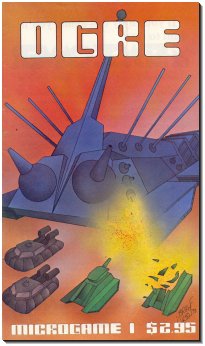
OGRE is a science fiction board wargame designed by the American game designer Steve Jackson and published by Metagaming Concepts in 1977 as the first microgame in its MicroGame line. When Steve Jackson left Metagaming to form his own company, he took the rights to OGRE with him, and all subsequent editions have been produced by Steve Jackson Games (SJG).
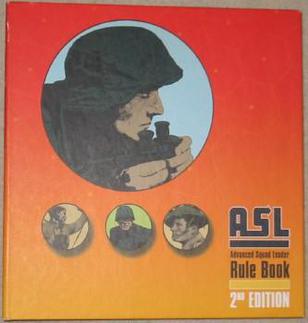
Advanced Squad Leader (ASL) is a tactical-level board wargame, originally marketed by Avalon Hill Games, that simulates actions of squad sized units in World War II. It is a detailed game system for two or more players. Components include the ASL Rulebook and various games called modules. ASL modules provide the standard equipment for playing ASL, including geomorphic mapboards and counters. The mapboards are divided into hexagons to regulate fire and movement, and depict generic terrain that can represent different historical locations. The counters are cardboard pieces that depict squads of soldiers, crews, individual leaders, support weapons, heavy weapons, and vehicles.

Warhammer is a tabletop miniature wargame with a medieval fantasy theme. The game was created by Bryan Ansell, Richard Halliwell, and Rick Priestley, and first published by the Games Workshop company in 1983.

Middle Earth Strategy Battle Game, previously marketed as The Hobbit: An Unexpected Journey Strategy Battle Game, The Hobbit: The Desolation of Smaug Strategy Battle Game, The Hobbit: The Battle of Five Armies Strategy Battle Game and The Lord of the Rings Strategy Battle Game, is a tabletop miniature wargame produced by Games Workshop. It is based on The Lord of the Rings film trilogy directed by Peter Jackson, and the book that inspired it, written by J. R. R. Tolkien.
Johann Christian Ludwig Hellwig was a German mathematician, entomologist and wargame designer.
Sniper!, subtitled "House-to-House Fighting in World War II", is a two-player board wargame about man-to-man combat in urban environments during WWII, originally released in 1973 by Simulations Publications Inc. (SPI). After TSR purchased SPI in 1982, TSR released an expanded edition of Sniper! in 1986, and followed up that up with releases of various "companion games" and a videogame.

Kriegsspiel is a genre of wargaming developed by the Prussian Army in the 19th century to teach battlefield tactics to officers. The word Kriegsspiel literally means "wargame" in German, but in the context of the English language it refers specifically to the wargames developed by the Prussian army in the 19th century. Kriegsspiel was the first wargaming system to have been adopted by a military organization as a serious tool for training and research. It is characterized by high realism, an emphasis on the experience of decision-making rather than on competition, and the use of an umpire to keep the rules flexible and manage hidden information. After Prussia's impressive victory over France in the Franco-Prussian War, other countries swiftly began designing Kriegsspiel-like wargames for their own armies.

Tactics is a board wargame published in 1954 by Avalon Hill as the company's first product. Although primitive by modern standards, it and its sequel, Tactics II, signalled the birth of modern board wargaming for the commercial market. Tactics is generally credited as being the first commercially successful board wargame.
David Wesely is a wargamer, board game designer, and video game developer. Wesely's developments, inspired by Kriegsspiel wargames, were important and influential in the early history of role-playing games.
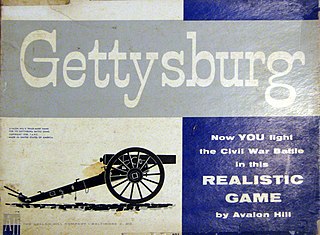
Gettysburg is a board wargame produced by Avalon Hill in 1958 that re-enacts the American Civil War battle of Gettysburg. The game rules were groundbreaking in several respects, and the game, revised several times, was a bestseller for Avalon Hill for several decades.

Siege of Bodenburg is a wargame developed in 1967 by Henry Bodenstedt. It is one of the earliest sets of rules for conducting battles with medieval miniatures.

A board wargame is a wargame with a set playing surface or board, as opposed to being played on a computer or in a more free-form playing area as in miniatures games. The modern, commercial wargaming hobby developed in 1954 following the publication and commercial success of Tactics. The board wargaming hobby continues to enjoy a sizeable following, with a number of game publishers and gaming conventions dedicated to the hobby both in the English-speaking world and further afield.
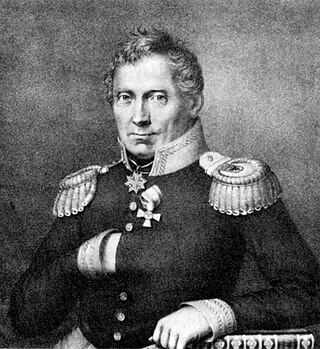
Georg Heinrich Rudolf Johann von Reisswitz (1794–1827) was a Prussian army officer. Reisswitz is regarded by many as the father of wargaming, as he developed the first wargaming system to be widely used as a serious tool for training and research. The particular genre of wargaming he developed is known in the English-speaking world as Kriegsspiel. It is characterized by high realism, an emphasis on the experience of decision-making rather than on competition, and the use of an umpire to keep the system flexible.

A wargame, generally, is a type of strategy game which realistically simulates warfare. A professional wargame, specifically, is a wargame that is used by military organizations to train officers in tactical and strategic decision-making, to test new tactics and strategies, or to predict trends in future conflicts. This is in contrast to recreational wargames, which are designed for fun and competition.
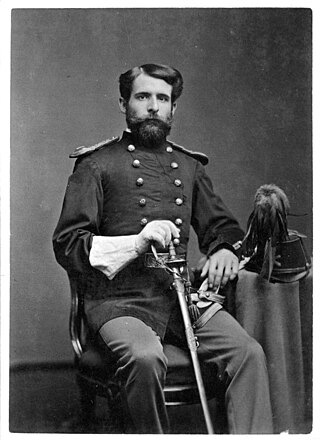
Strategos is a military wargame developed by Charles A. L. Totten for the United States Army, and published in 1880.

Napoleon at War, subtitled "Four Battles", is a collection of four board wargames published by Simulations Publications Inc. (SPI) in 1975 that simulates various battles fought by Napoleon.